Religion
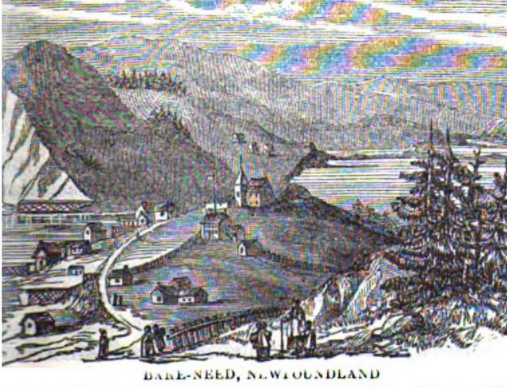
Prior to 1779 there was little choice regarding religion in Conception Bay since there were restrictions on Roman Catholics practicing their religion and for Protestants there was only one Church which was St. Paul’s in Harbour Grace that opened in 1764. Even though restrictions on practicing other religions were removed in 1779 there were still attempts to restrict religious freedoms well into the 19th century especially for Catholics but also for Methodist (see below).
| 28 Sept. 1816 | From: David Rowland, Missionary and officiating garrison chaplain (St. John’s) | Request from government to prevent the recurrence of Methodist ministers solemnizing the rites of marriages in St. John’s contrary to the laws of the realm. CO194/CO194-59 |
Prior to the establishment of St. Paul’s in Harbour Grace the closest church to Bareneed was St. John the Baptist in St. John’s (the oldest Anglican parish in Canada dating from 1699). However, getting to St. John’s from Bareneed would involve a round trip sea voyage of aproximately 200 km much of it in the open North Atlantic.
While St. Paul’s was Church of England the preaching depended on the minister who frequently had Methodist leanings. The first Church of England priest to serve in Conception Bay and the third then resident in Newfoundland was Rev. Laurence Coughlan, a newly-ordained Church of England priest who had been converted to Methodism some 13 years previously. Though supported by the Anglican Society for the Propagation of the Gospel, Coughlan, who was based at Harbour Grace, effectively established Methodism in Newfoundland (source Newfoundland Methodism).

James Balfour was appointed as minister of St. Paul’s in Harbour Grace in 1775 (transfered from Trinity). His first task upon arrival was reintergrating the Parish into the Church of England.
The inhabitants of Carbonear had been influenced by the Methodist teachings of his predecessor Laurence Coughlan* and consequently wanted either a Methodist or a Presbyterian minister; moreover, they claimed the church was their property and refused him entrance. An order from Governor Richard Edwards* in 1780 enabled Balfour to use the Carbonear church, but in January 1784 he was bothered when a Methodist preacher intruded into the pulpit in the middle of a service. Source: Frederick Jones, “BALFOUR, JAMES,” in Dictionary of Canadian Biography
The following is summary of Rev. Balfour’s travels in 1786 and the number of baptisms he performed at each location.

He does not record any at Bareneed but several of those recorded in Port de Grave are likely from Bareneed: ANTHONY NORMAN SNOW MUGFORD RICHARDS DAW DAW TAYLOR HUSSEY. I did notice that modern Harbour Grace records online only record 9 at Port de Grave vs 17 in this report! The other community totals look ok. Either this report is wrong or some Port de Grave Records got lost or mislabled since 1907. The latter is likely the case since Balfour is recorded as having baptized 8 children at Harbour Grace on June 18 & 19 (the time he was in PDG). These have names: BOON, ANDREWS, BUTLER, COVEDUCK, BATTON, BRADBURY, PARSONS that may be from Bareneed. Regardless it was a busy summer for someone who was 55 and ill.
The Methodist became established in Conception Bay in the 1790s when they opened Churches in Carbonear (north of Harbour Grace) and Brigus (south of Bareneed). These two communities had strong Methodist congerations. In addition, they continued to visit communities like Bareneed. See the following entries from the Journal of William Thoresby, Methodist Missionary (Cited from Mary Angelil Robinson’s MA Thesis, 1996).
·Jan. 6 (1797). Several friends came this day to Carbenear for me to go to
Port de gave [port de Grave)”; “I got ready immediately and went with them-;
-Jan. 11. I went in a skiff half a league to Beorned [Bareneed] and stayed one
rught..and in the morning I preached to them…and set off in a boat two-thirds of
a league to Cupit [Cupids), and walked two miles to Brighouse [Brigus]-;
In the late 1700s residents from Bareneed only had two choices if they wanted to solemnize their marriage and/or get their children baptized in the Church of England. The first was a 24 km sea voyage to Harbour Grace which was not only difficult but also resulted in loss of fishing time so these trips were generally postponed until the next visit for other business (no more than once or twice per year). The other was to wait for the minister at Harbour Grace or a missionary from the Society for the Propagating the Gospel (SPG) to visit their community. This involved the minister travelling to different comunities by boat, staying with locals and conducted services in what ever building was available. The minister at Harbour Grace might make one or possibly two tours of Conception Bay each year. The following is the itinerary for the Rev. Balfour, Minister at Harbour Grace, for his trips in 1786. Bareneed is not recorded but several people recorded at Port de Grave are likely from Bareneed.
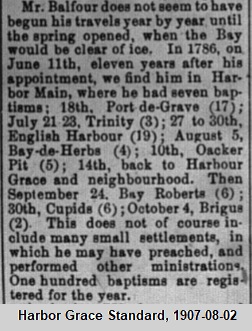
A SPG Report Published in 1851 gives the following History of the Church at Bareneed.

The author of this report stated that the first church at Bareneed was built around 1816; however, earlier SPG documents (see below) show that the first Church at Bareneed was erected in 1805, making it one of the first outside Harbour Grace. A report of a visit to Bareneed by Captain Hercules Robinson in September 1820 demonstrates that at that time the Church at Bareneed was owned by a private individual and that the SPG minister at Harbour Grace had to ask permission to use the church (see report on visit later in this section).

This report further states that pews were sold in payment to raise money for the new Church. This concept of pew ownership was still recognized in 1844; the Will of William Beauchamp of “Barened” written in 1844 states that I give and bequeath all my right title and interest in and to a pew situated in the Church at Barened with my bed and bedding and chest unto William Henry Lacely,
Initially, the Church was not staffed by a full time minister but was used for Sunday readings led by a Catechist (lay reader often the school master who was appointed by the SPG) or for services when SPG missionaries visited the community once or twice during the summer.
During this period there were also Methodist missionaries operating in Conception Bay. The following list from Newfoundland and its Missionaries list the Methodist missionaries stationed in Newfoundland in 1816.

The following is a Letter from Rev. John Lewis (see above) reporting on conditions in Port de Grave and Bareneed in 1816.
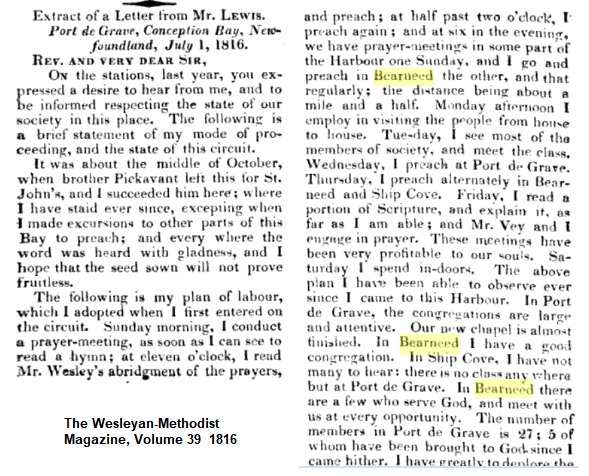
One of these Methodist Missionaries William Ellis arrived in Newfoundland in 1808 and for five years, he, John Remmington, and Samuel McDowell ministered in the settlements on the north side of Conception Bay and on the south shore of Trinity Bay. Ellis remained in Newfoundland for the remainder of his career and died on 21 Sept. 1837 in Harbour Grace, Nfld. In 1819 Ellis baptized six Labrador Indians at Bareneed (see the History 1805-1818 section of this Web Site for more information on this event).
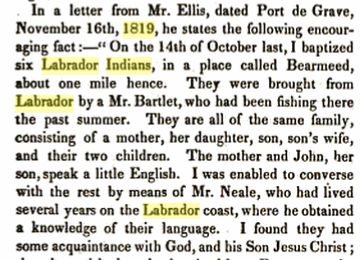
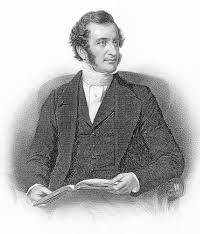
The following, also from Newfoundland and its Missionaries, list the Methodist missionaries stationed in Newfoundland in 1823.

In 1820 John Leigh the Church of England minister at Harbour Grace who was also a Justice in a Surrogate Court sitting at Bareneed on July 5th 1820 summoned a James Landrigan of Cupids to appear before it, regarding a a debt of £13 with the firm of Graham McNicoll and Company, but Landrigan declined to attend. Landergan was then apprended and taken in a boat to Bearneed, and put on board his Majesty’s Ship Grasshopper, where he was kept a prisoner during the night. The next morning the Grasshopper removed to Port de Grave, where a Surrogate Court was opened, before Leigh and Capt. Buchan of HMS Grasshopper.
Lundergan ,was charged with diverse contempt’s of Court, and resisting constables in the execution of their duty, and particularly with refusing and neglecting to attend the Surrogate Court held at Bearneed, on the preceding day. He was then taken to a flake near the house, tied to it by his hands and legs, and the Boatswain’s Mate of the Grasshopper inflicted 14 lashes. When the plaintiff fainted. he was then cut down and carried into the house where the Court was held, and laid on a bench, where he was some minutes very much convulsed (see https://johnpnewell.com/bareneed/history-1805-1818/ for more info).
Public indignation was aroused and Buchan and Leigh were censured when the case was brought to the attention of the British Government. Leigh died in Aug. 1823 but this case likely left many residents of Bareneed with a less than ideal view of the established Church.
In September 1820, Leigh accompanied Captain Hercules Robinson of HMS Favorite on a voyage from Harbour Grace to Bareneed. Robinson was engaged in in a survey of the coast of Newfoundland and Labrador and Leigh likely took advantage of Robinson’s trip to visit this part of his Mission. Robinson described “Bare Need” as: a pretty little town, containing about 250 inhabitants. In his Journal Robinson makes the following observations regarding the Church at Bareneed. This establishes that in September 1820 the Church building at Bareneed, built sometime between 1805 and 1816 (see above), was not part of the established Church! It was likely built by this individual to provide a venue for visiting Methodist missionaries.
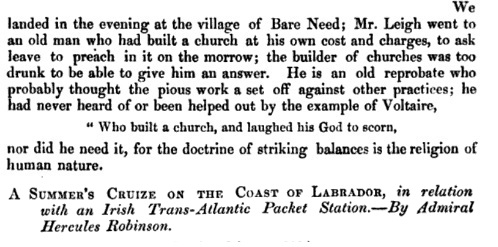
By the mid 1820s the Church of England operating through the SPG was restablishing its dominance in Conception Bay. The following extracts are from a report on the state of the SPG Mission in Conception Bay by the Rev. John Burt published in a 1824 SPG Report. I have included his general remarks and those that relate to Bareneed.
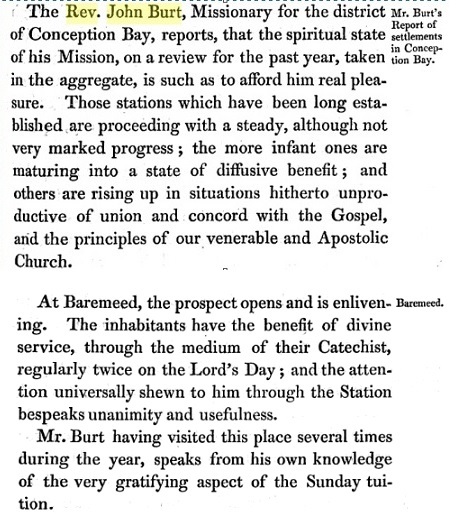
Rev. Burt first came to Newfoundland in 1819 as part of a failed attempt to establish a seperate mission in Carbonear (a Methodist stronghold) and in 1822 he took over responsibility for Harbour Grace and the other missions in Conception Bay from the Rev. John Leigh. He remained at Harbour Grace until 1840 and from 1822 until 1827 he made several visits each year to the other missions in Conception Bay, including Bareneed, to performe Baptisms, Weddings and to offer Communion. During these years there were still regular Sunday services in Bareneed officiated by John Sarrell, a Catechist who was also the school teacher and received a stipend from the SPG. From September 1822 to June 1827 the Rev. Burt made at least 10 different visits to Bareneed and performed 58 Baptisms. On one 2 day period in January 1827 he baptized 18 children at Bareneed.
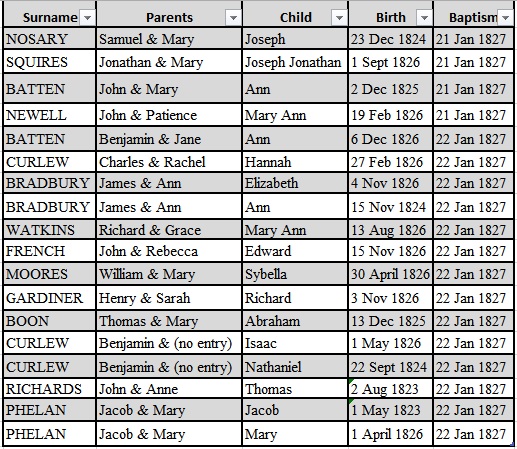
In 1825 Thomas Cochrane noted in his Journal that there is an Episcopal Church at Bareneed — and a Catholic, an Episcopal and a Wesleyan Chapel at Port de Grave — there is also a Wesleyan Chapel at Cupids
In 1826, the mission of “Port de Grave, Bay Roberts and Bare-need” was established to serve the area from Bay Roberts to Brigus and in 1827 Rev. Charles Blackman was stationed at Port de Grave and served this area. Also in 1827 St Mark’s Church in Bareneed was consecrated by Bishop John Inglis (Bishop of Nova Scotia who had responsibility for Newfoundland at that time).

Rev. Blackman was still serving in the Mission of “Port de Grave, Bay Roberts and Bare-need” in 1835. At that time Archdeacon Wix who was visiting noted that the Church at Bareneed requires enlarging.
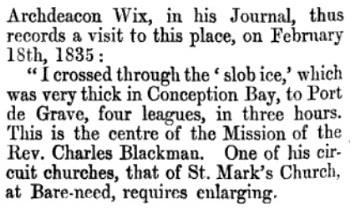
It is interesting that despite the earlier Methodist missionary activities in this area there were no Methodist (Dissenters) recorded in Bareneed while in Port de Grave they represented 15% of the population. One reason for this might be that the established Church in Bareneed already had Methodist leanings.
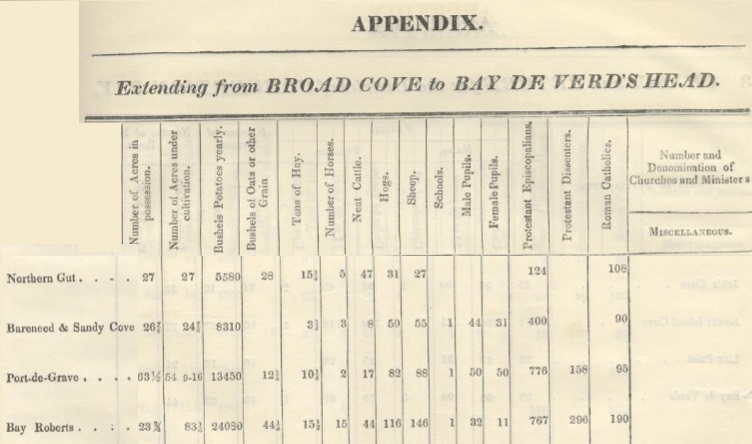
One of the first Methodist converts was William Sealey of the Dock who accoding to the following converted c 1837.
Memorial Notice: WILLIAM SEALEY- On Wednesday, the 29th December 1880, at Bareneed, Conception Bay, Newfoundland, after a week’s illness, William Sealey passed hence in the 60th year of his age. He was converted to God in his seventeenth year, when he at once identified himself with Methodism. Several years ago when one Methodist internerant travelled the ground now covered by two Brother Sealey rendered our cause good service as class-leader and local preacher. In reply to a remark of the writer, he said when dying: “My work is done. I’m going home to be with Jesus.” He was a good man and died lamented by a large number of friends. Port de Grave, Jan. 12 1881 Rev. E. Taylor
Marriage records from the Methodist Church in Port de Grave demonstrate that there were members of the Richards, Boon (Boone) and Beacham families from Bareneed who were getting married in the Methodist Church in 1845 (see below). Isaac Richards (1833-1898) was the father of Jesse Richards of Bareneed b 1857 who moved to Little Brehat. The publication History of Methodism in eastern British America states that: At Little Brehat, the name of Jesse Richards will always be remembered. The William Sealey who witnessed the Beacham/ Lamb marriage in 1845 is the William Sealey referenced earlier.

By 1847 the residents of Bareneed and The Dock were contributing to the Newfoundland Church Society. This Society was founded in 1841 to raise money within Newfoundland to support churches and schools in the colony. The money raised by the Society was intended to reduce and eventually eliminate support provide by the UK based Society for the Propagation of the Gospel, on which the Church in this Colony has hitherto depended for support, is no longer able to extend and increase its bounty to us as our increasing wants demand. The rules of the Society included the following outlined in the Report of 1847.

The SPG Mission for Port de Grave, which included St. Mark’s Church in Bareneed, was one of 22 missions that contributed funds in 1846 (reported in 1847). The Newfoundland Church Society report for 1847 list individuals that contributed (see below). Support for the Church Society was not universal and varied depending on religious viewpoints and economic conditions. It likely did not include many, if any, Roman Catholics and Methodist (the former represented aproximately 15% of the population at that time and the latter 4%). It would also exclude anyone who did not contribute for financial or other reasons.
The following list shows contributions made in 1846 (amounts in pounds, shillings and pence).

Ten years later the same Church Society Report for 1857 combined all of Bareneed into one list with 94 subscribers. By this time Roman Catholics represented approximately 10% of the population and Methodist 5%.

The Newfoundland Census for 1857 gives the population of Bareneed as 432 with 67 inhabited houses and the population of the Dock as 151 with 23 inhabited houses (with 25 families). With 92 families a number of which are Roman Catholics and Methodist and 94 suscribers it suggest that there were frequently multible subscribers in a family (perhaps single adult sons living at home).
The following chart shows the religious affiliation of the combined population of Bareneed and the Dock from 1836 on (the period with data).

What it demonstrates is that the Church of England (Anglican Church) remained the dominant religion in Bareneed throughout the historical period. In 1836 23% of the population of Bareneed (includes the Dock and Sandy Cove) were recorded as Roman Catholic compared to just over 9% in Port de Grave. The early years of the Nineenth Century in Newfoundland were a period with relatively cordial relations between religious denominations in Newfoundland (see article below published by Patrick Morris, a Roman Catholic, in 1827) Perhaps both sides felt equally opressed by the Colonial Government.

However, the percentage of Roman Catholics in Bareneed dropped off rapidly during the mid 19th century.
At the start of the Ninteenth Century there were people living between Sandy Cove (western Port de Grave) and what is now eastern Bareneed. Local lore suggest that many of these were Roman Catholic and many of these moved to Otterbury and North River (aka Northern Gut) during a period of anti Catholic tensions in the mid 1800s. These tensions were caused by spillover from the Fenian Rising of 1867 in Ireland and Fenian Raids in Upper Canada. These religious tensions were exasperated by the Orange Lodge which was especially strong in Port de Grave. As the following suggest, Bareneed represented a somewhat of a Buffer Zone between the two factions.
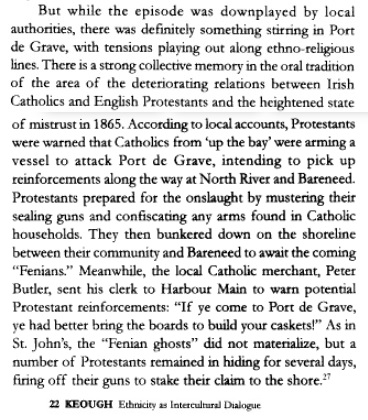
As a result of these tensions most Roman Catholic residents of Port de Grave relocated to North River or further south in Conception Bay (the area between Brigus and Holyrood was predominantly Roman Catholic). The area between Sandy Cove (west end of Port de Grave) and Bareneed, that was predominately Roman Catholic, was completely depopulated as a result. The last Irish Catholic resident of Port de Grave was local merchant Peter Butler who died in 1901, after Butlers funeral the local Roman Catholic Chapel was torn down after standing for almost 100 years (see G.W. Andrews, 1997, p.123-128).
The Census of 1857 provides a summary of religious affiliations in Bareneed and surrounding towns (unlike the 1835 Census the Dock and Sandy Cove are now seperated out). The combined population of Bareneed and the Dock is now 583 of which Roman Catholics represent just under 10% and Wesleyans (Methodist) just over 4%. Since 1835 the Roman Catholic population has declined from 90 to 57 (adding back Sandy Cove would increase the number by 8) and the Wesleyans (Methodist) have just started to increase. The data for Places of Worship show that Port de Grave had 3, one each, while Bareneed just had a Church of England church and there were none in the Dock. The fact that here were two schools in Bareneed may indicate that the Wesleyans (Methodist) had a school but no church. One area where this Census data may be suspect is that it does not record any Wesleyans (Methodist) in The Dock (see earlier discussion of the William Sealey’s conversion c 1837.
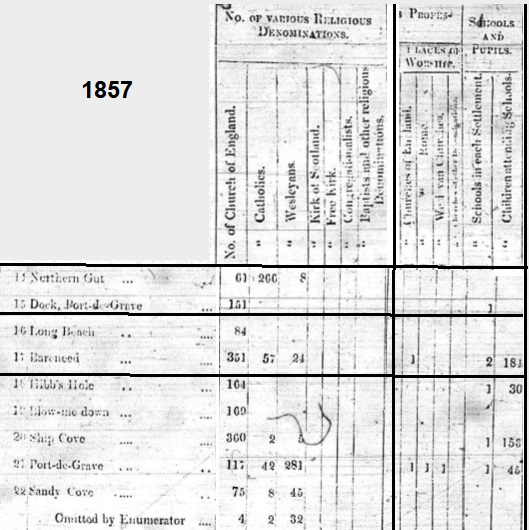
The 1857 Census indicates that there were 24 Methodist in Bareneed but none in the Dock. This is surprising since starting in the late Nineteenth Century the Dock had a much stronger Methodist leaning than Bareneed (reaching 47% in 1911 and 52% in 1945). The Methodist/United Church was in the west end of Bareneed near the Dock. After 1900 there was also a small Salvation Army community.
The decline in the Roman Catholic community coincided with an increase in the Methodist (later United Church) community. However, this is deceiving since the growth in Methodist was largly driven by defections from the Church of England. Many of the early (pre 1836) missionaries in this area had strong Methodist leanings and the first Church of England ministers that served the community, Rec Charles Blackman who served in the 1830s and Rev. Johnstone Vicars who served from 1839-1851 had a more evangelical orientation (preaching from the pulpit) and less emphasis to ritual (see following section). As a result the population had views that were receptive to Methodist. This would likely not have been a problem except that in 1844 Edward Feild became Bishop of Newfoundland.
Edward Feild Church of England Bishop of Newfoundland from 1844-1876 had a High Church (tractarianism) bias. In the Anglican Church, low church refers to those who give less emphasis to ritual and had a more evangelical orientation (preaching from the pulpit). The term is most often used in a liturgical sense, denoting a Protestant emphasis, whereas “high church” denotes an emphasis on ritual, often Anglo-Catholic. This was in direct opposition to many of the local clergy that serverd in Bareneed before and during his tenure as Bishop. Rec Charles Blackman who served in the 1830s; Rev. Johnstone Vicars who served from 1839-1851 and Rev. J.C. Harvey who served from 1852 -1890 were all in the Low Church camp. Bishop Field alienated many congregations by insisting they redesign their Churches to conform to his High Church ideas. One of his demands is that he pulpit should not be front and center in the Church (where it was in many Newfoundland churches) but moved to the side to move focus from the pulpit (preaching) to the alter (ritual). Calvin Hollett reviews this issue in his paper Let There Be No Galleries. Hollett provides the following quote from Feild: Bareneed, 31st of July 1844, the church is small and crowded with galleries and pews of the worst description.
Surprisingly, anothe big issue was wearing a Surplice (a loose white linen vestment worn over a cassock) in the pulpit. The Bishop insisted that priest wear the surplice in the Pulpit while the congregation and low church clergy resisted. This led to conflicts between the clergy and their congerations when they tried to follow the Bishop. The following extracts from The Journal of Oliver Rouse demonstrates how this affected Rev. Vicars.
18th June 1847 About mid-day Revd. Mr. Vicars called (visited Oliver Rouse) . Speaking about the surplice etc, he said that he had learned from experience that it was a very unwise thing to loose the affections of your people by acting contrary to their wishes in such matters; and that we [? read he?] would never do so again. “When once the people become suspicious of their minister’, he said, “his usefulness is very much destroyed.
August 1847 Mr. Prowse told us there had been some unpleasantness between Mr. Vicars and his parishioners again. It is a sad thing.
September 1847 In the afternoon, prayers being ended, the Bishop delivered his charge. It was his wish that the Surplice should be worn.
Vicars resistance to Feild did not damage his reptutation in the community and based on the following
Farwell to Rev. Johnstone Vicars from his Congregations in Bareneed and Port de Grave published in the Morning Courier, 1852-07-24 his views fit with those of the community.
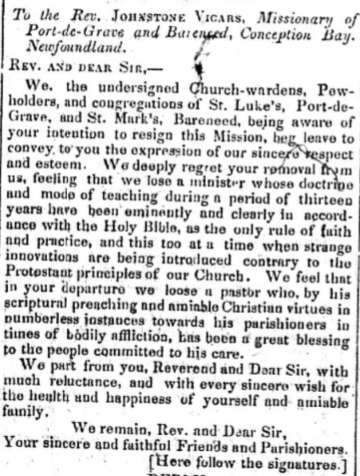
Note comments regarding strange innovations which is likely directed at Bishop Feild. Vicars use his reply to indirectly attack Bishop Feild.
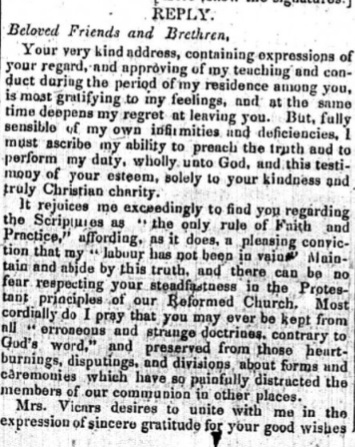
Calvin Hollett makes the case (see below) that Bishop Feilds policies drove some people in Port de Grave (Parish for St. Mark’s in Bareneed) away from the Church of England.

However, negative impacts from Bishop Feilds policies were tempered in Port de Grave parish by Rev. J.C. Harvey who served from 1852 -1890. Harvey, who also had Low Church leanings, was perhaps more of a diplomat than Blackburn and Vicars and in addition he was well liked and respected in the community which made it more difficult to confront him. This is demonstrated by the Farwell he receive when he departed the community (see below).

The following sketch shows the Church at Bareneed c 1851 which was replaced in 1860 (see below).
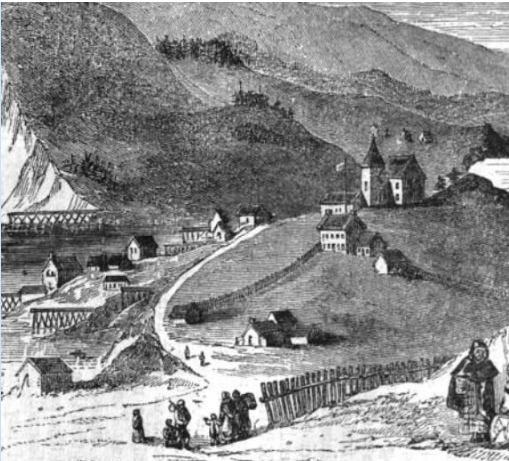
The sketch and followin description of the church with a gallery and no indication of seperate chancel suggest the type of church building that Bishop Feild would not approve of.
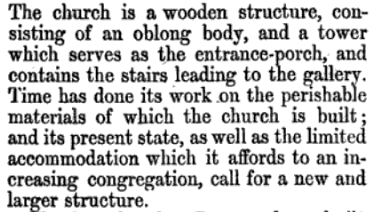
From the 1851 description it is clear that the church at Bareneed needed to be replaced. In 1860 a new, handsome, commodious and well-built , Church was consecrated at Bareneed. This building was a result of cooperation between Rev. Harvey and the community.
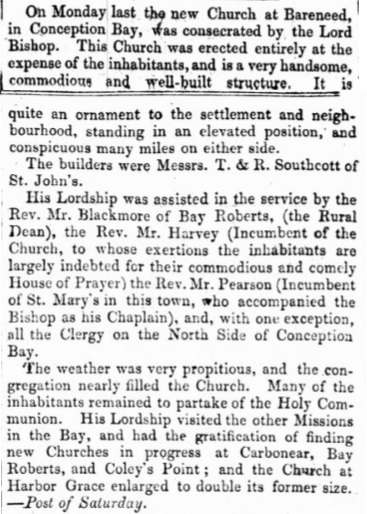
It is likely that Rev. Harvey raised money for the church by selling pews. In his Will written in 1864 , Samuel Batten Senior of Bareneed leaves his pew in the Church to his grandson – The pew in the church in Bareneed belonging to me I give and bequeath to Isaac son of my aforesaid son Thomas & his heirs.
The 1860s was a period of Religious discontent between Protestants and Catholics in Conception Bay with roits in Harbour Grace. Protestants in Port de Grave appears to have been especially sensitive to roumors of Fenian uprisings. Based on the following analysis it appears that Bareneed, situated between Port de Grave and predominatly Catholic North River seems to have been in no man’s land.

In January,1875 the Rev. J. C. Harvey, minister for the churches at Port-de-Grave and Bareneed , had to travel to England, “for the purpose of promptly obtaining medical advice”. As a result Bishop Edward Feild stepped-up to take charge of the congregation during his absence. Bishop Field describes this as “the longest, coldest winter, ever known to any living person in Newfoundland. Since Christmas the frost has been almost continuous, and the quantity of snow which has accumulated is wonderful.
After the Lenten Ordination a newly-ordained deacon, the Rev. A. C. Waghorne [see photo], who had just arrived from England, was sent to assist the bishop at “Bare Need”. Here are some of his comments regarding his winter in Bareneed:
The day after my arrival the bishop took me to Bare Need for service, and to introduce me to his people. The church I found to be a good sized building, and of its sort a fine specimen. It will seat, I suppose, 500 or 600 people. It was now the middle of winter, and that the most severe, so people say, for many a year past,–and in such a large church and no stove in it, no wonder the bishop was almost frozen… A winter of such severity was not likely to pass away without leaving some legacy in the shape of vacant missions and sorrowing households: while the bishop was at Port-de-Grave a young schoolmaster [from England] perished in a snowdrift at the western point of the diocese.
Source: Memoir of the Life and Episcopate of Edward Feild, D.D. Bishop of Newfoundland, 1844-1876.
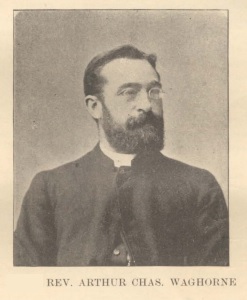
Rev. Waghorne soon adapted to life in Newfoundland.
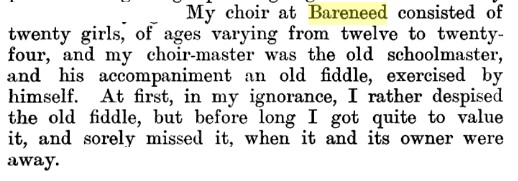
While in England Rev. Harvey continued fundraising for the church.

The Rev. Harvey was back in Port de Grave in April 1875 and in December 1889 Rev. Harvey left the Parish after 37 years.
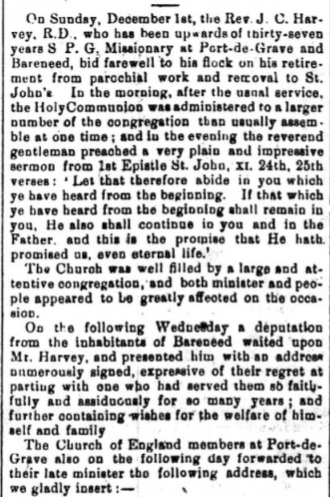
After Rev. Harvey’s departure the Rev. T.G. Netten was the minister for the remainder of the 19th Century. Shortly after his arrival the Ladies of Port de Grave and Bareneed sponsored a fundraising Tea.
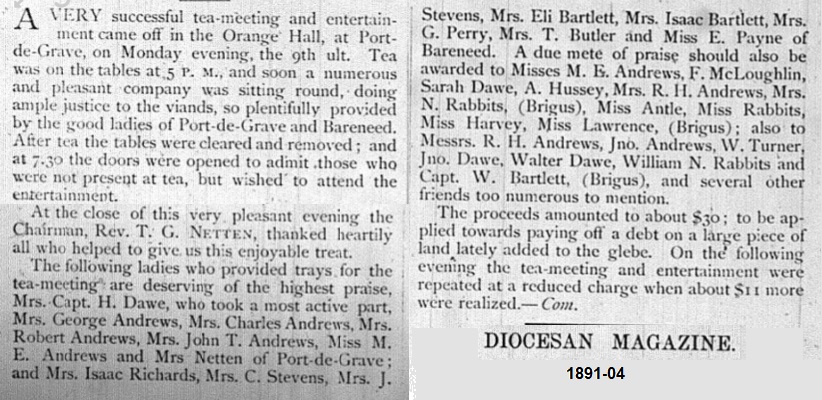
In 1893 work started on a new graveyard for Bareneed and drunkenness was down.
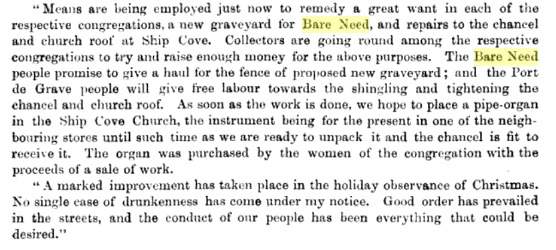
The following image c 1906 shows the Church of England Church at Bareneed that was replaced in 1930; unless there was another replacement this would be the church built in 1860.
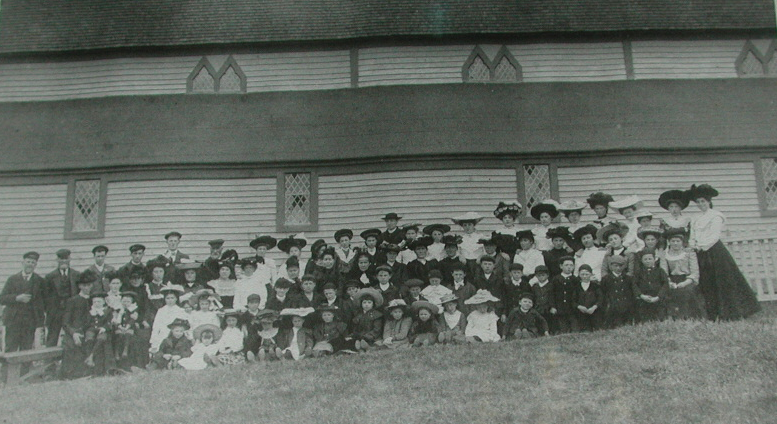
The following is a list of people in the photo. If the Front Row is Right to Left then the 3rd boy in would be Harry Greenland b 1899.

Rev. Cramp and his wife Helen nee Simmons in the group photo from 1906. He arrived in the Parish in early 1901 (appointed to Board of Education in January, Evening Telegram, 1901-01-16). He left the Parish in June 1906 to take up a post at a “Newely-founded colony of Englishmen” at Lac La Noune, Alberta.

The 1911 Newfoundland Census shows that greater Bareneed was just under 27% Methodist (21% in Bareneed versus 38% for the Dock). The members of the Salvation Army at Bareneed (from census details) were Samuel Bartlett (b 1852) and his sister Susanna (not counted in summary).

There is much less information on the Methodist (after 1925 United Church) Churches in Bareneed. I have not been able to find any references to to a Methodist Church in Bareneed before the construction of a new Methodist Church in 1916.
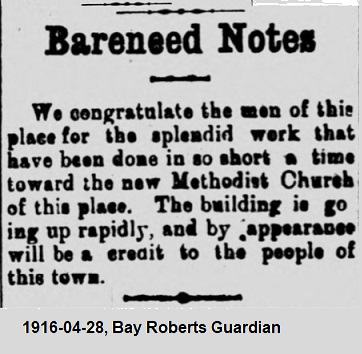
The Marriage records for Clarkes Beach (the Methodist Parish Church for Bareneed) only show one Methodist marriage recorded at Bareneed. This was for Isaac Snow of Salmon Cove & Ann Norman of Bareneed who were married on 13 Dec 1856.
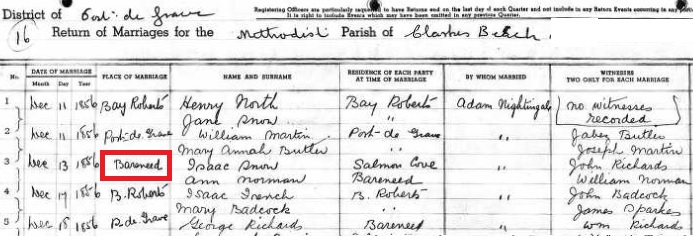
Subsequent to this there were marriages for people from Bareneed; some of these were at neighbouring communities but in many of these cases no location was recorded!
The following photos show the front and rear views of the United Church at Bareneed built in 1916. The The Church closed in 1992. It was situated at the fork in the road in western Bareneed with the road to The Dock to the left and road to the Pond to the right in the fron photo.
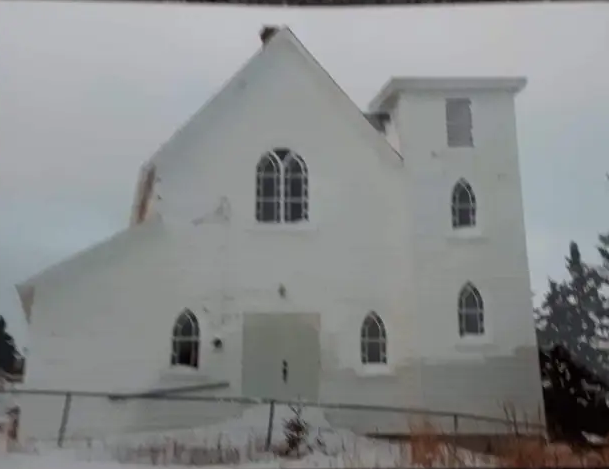

The following info on this Church was posted on the Web by Lloyd Rowsell Subject: [NF-ROOTS] Bareneed Methodist Surnames Date Posted: Thu, 24 Oct 2002
The present Bareneed Methodist Church (est. 1815, lay ministry since 1765) was built in 1915 under the supervision of Nathan Newell. Pewholders were: Left side (south) Lemuel Batten, Thomas George Beecham, Dan (Daniel) Curnew (Curlew), George H. Bartlett, A.A. French, Mrs. Margaret French, , Albert Richards,
Thomas Richards, Skipper George Richards, William Richards,….Center: Moses Batten, James S. Dawe, Thomas French, Samuel Kingsley (Kinsla?), George Richards, James Richards, William Seeley, ….Right Side: Nathaniel Beecham (aka Beauchamp earlier)–(brother of Thomas George Beecham, James John Dawe, John Bishop Dawe, Isaac Dawe, William Lacey, John Newell (supervisor Nathan’s brother), Abe (Abraham) Richards, George Richards. This information is provided by Anne Sparkes Coddington, who for a short time owned the church building a few years ago and wrote a brief history.
By the 1920s it was clear that a new CofE Church was needed and the corner stone for the new Church was laid in 1926.
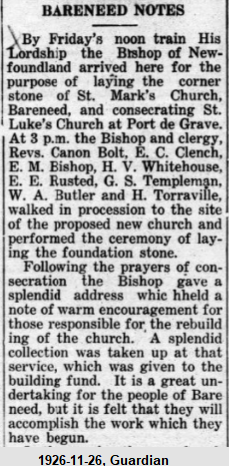
The new Church was known as the “Free-labour Church” since it was built by local craftsmen who donated their time under the direction of William Henry Batten the master builder from Bareneed. William Henry Batten and a Mr. Stevens, both of Bareneed, went on to be the Master Builders for “All Saints Anglican Church“ in Foxtrap (corner stoned on June 8, 1931 and consecrated on October 31, 1937).
The congregation at Bareneed raised money for their new Church by organizing fundraising events like this Garden Party in 1928.

The following photo shows St. Mark’s Church Bareneed c 1940, this building was consecrated in 1930.
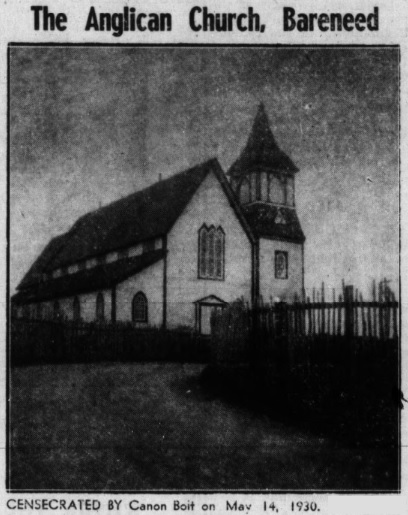
The following recent photos shows the 1930 St. Mark’s Church (now deconsecrated).
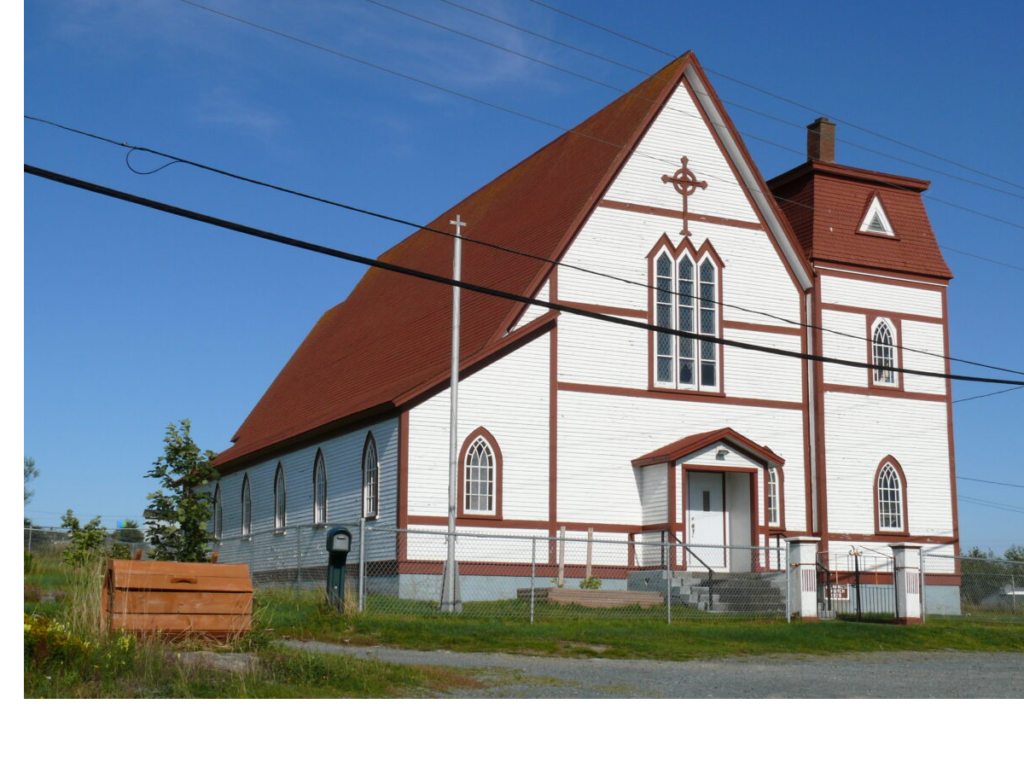
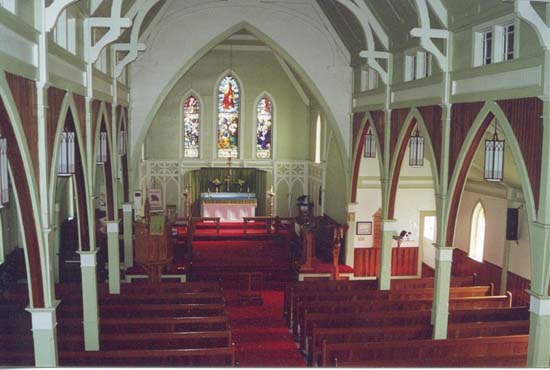
Up to this point we have tracked the Ministers who came to Bareneed; however, in the late 19th and early 20th centuries Bareneed produced a number of Ministers of its own. One of the earliest and perhaps most noteworthy was Cannon Richards.
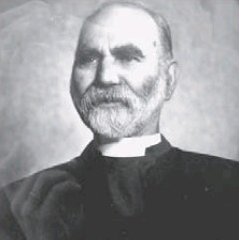
The Rev. Canon John Thomas Richards is buried in St. Mark’s Churchyard. Canon Richards was born in Bareneed in 1875 and was a missionary on the coast of Labrador for 41 years
| Feb 18, 1875 | Bareneed | RICHARDS | John & Elizabeth | John Thomas |
See his Bio in Newfoundland who’s who 1952

Cannon Richards was more than a minister on the coast of Labrador he also played a role in developing the community. It was Canon Richards who recognized the people of his mission were skilled and capable of curing and tanning seal skins, as well as producing quality seal skin boots. St. Barnabas Church is locally known as the “Skinboot Church” because Canon Richards commissioned the local people to make skin boots to sell and raise money for the construction of the church. In the days before government funding for such projects and in an area where money was scarce Richards set about raising funds to build a proper church through the efforts of him and the parishioners. The motivation to have a place of worship launched an industry to make seal skin boots and it became a $15,000 a year project. A secondary goal was to provide employment for the coastal people ( source: St. Barnabas Anglican Church Historical designation) .
The Cannon Richards Memorial Academy in Flowers Cove is named after him. In 1945 he was transferred to a less demanding position in the Parish of Port de Grave (includes Bareneed). In 1949 he was made a member of the [Order of the British Empire]. He retired from active parish work in 1952 (he baptized me the previos year) and lived in the Dock until his death in 1958. For more information see his biography: Sealskin Boots and a Printing Press by Irving Letto.
Another son of Bareneed who served as a minister at Flowers Cove and a number of other locations was Rev. Harris Batten. See his Bio in Newfoundland who’s who 1968 below.
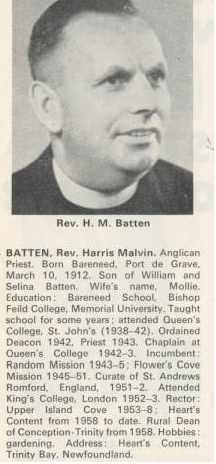
One family from Bareneed is noteworthy for the number of Methodist Ministers it produced. William Sealey (1820-1880) and his wife Rebecca Richards were the parents of the Rev. William Richard Sealey / Seeley B:1860 Bareneed, D:1941 Victoria, British Columbia, Canada. The Elder Rev. W.R. Sealey (there was a later Rev. W.R. Sealey from Bareneed who was his nephew) was ordained by the Methodist Church in 1896 and served in Ontario in 1899 (see below)
Singhampton, Ontario, Oct. 27th. ,1899. A fair attendance at this meeting, presided over by Rev. F. Davey, Pastor. The new Methodist minister, Rev. W. R. Seeley, gave an able and warm-hearted address on the Bible and the benefits of its circulation. Having been once a missionary for the American Bible Society in Labrador and Newfoundland he was able to speak intelligently and with authority (Archives of UPPER CANADA BIBLE SOCIETY)
Later he served in Alberta, Saskatchewan and British Columbia (see obit below).

The Elder Rev. W. R. Sealey had a brother Thomas George Sealey who was a lay reader at Hant’s Harbour, Newfoundland (see their family tree below) . Despite not being ordained Thomas G. was recognized in the publication History of Methodism in eastern British America Pub. c 1925.
Next Thos. Seeley of Bare Need settled in Hants Harbor making it a headquarters from which to sell books. He was, though not so employed, a true colporteur and wherever Sunday found him preached, very often of course at home.

The Elder Rev. W. R. Sealey had another brother Abraham R. who married Mary Jane Batten, they had two sons both of which became ordained Methodist ministers. These were The Rev. W. R. (the younger) and the Rev Thomas George (a nephew of the elder Thomas George).
The Rev. W. R. the younger (born 1886 at Bareneed) was a school teacher in Newfounland before being ordained as a minister in the Methodist Church in 1910. In 1912 he moved to Canada where he attended Mount Allison University (sponsored by the Church) after which he was Minister in Sydney Mines Nova Scotia, a community with a large number of Newfoundlanders who were working in the coal mines.
His brother, Thomas George the younger (born 1891 at Bareneed) also attended Mount Allison University in New Brunswick. He was ordained in 1914 and after serving in Millertown/Badger Newfoundland he was posted to Saskatchewan and then to Winnipeg MA. where he died at a young age in 1924.

There is one more Seeley connection to the Methodist Church. William Sealey b 1820 had a daughter Rebecca G. who married Edward Mercer of Bay Roberts at Cupids in 1878. In 1881 they had a son William Seeley Mercer and while he is reported as growing up in Bay Roberts there is no record of his birth there! It is possible that he was born at his mothers home in Bareneed; however, there is no record of his birth. His parents moved to Alberta c1906 where they homesteaded near Pincher Creek,
He also attended Mount Allison University and was ordained at the Methodist Church in St. John’s in 1912 after which he was a Methodist Missionary in Labrador. William Seeley Mercer served in the Hamilton Inlet and Esquimaux Bay mission of the Methodist Church , 1912-16. The following two extracts are from the Labrador Memoir of Dr Harry Paddon, 1912-1938.
There were in all sixteen families besides the hospital unit and a bachelor Methodist padre [ Rev. W.S. Mercer ] . The padre was a bold sailor who often cruised solo in his taut little Glad Tidings and was also a hardy winter traveller who drove his own team.
The Reverend W.S. Mercer had been bound to Kenemich by dog – team on a pastoral visit when he saw what looked at first like a seal on the ice ahead . The dogs saw it too and promptly bolted . As he drew nearer , the padre saw that it was no seal but the head and shoulders of a man in deadly peril . Malcolm had got onto bad ice , which foundered under him . He was holding grimly on to the last , with no hope of getting out unaided . Stopping his dogs with difficulty , the padre took his long whip and crawled cautiously towards the hole . Too much haste might easily end in a double tragedy . Presently , he was near enough to shoot out the last of his whip so that the end was within reach of the drowning man , who seized it and wound it repeatedly around his wrist . Then , taking a further grip with both hands , he was slowly drawn out of the hole to safety . Then , wrapped for the moment in the dogskin mat to be found on most komatiks , he was rushed home and laid in warm blankets and dosed with hot tea , and the tough old veteran was soon none the worse .
In 1922 he married Mary Evangeline Longley from Nova Scotia.
MERCER – LONGLEY. At ten o’clock on the morning of Wednesday, Sept. 6th at “Hillside Farm” the residence of Mr. and Mrs. Joseph LONGLEY of Paradise, N. S., their daughter, Mary Evangeline, was married to the Rev. William Seeley MERCER of Bay Roberts, Newfoundland. The officiating Minister was the Rev. F. Stewart KINLEY of Windsor, N. S., an uncle of the bride, assisted by her Pastor, the Rev. W. Steadman SMITH. Mrs. Ewart G. MORSE, a sister of the bride, played the wedding march. Leading the procession to the drawing room, where the ceremony took place, came two pretty flower girls, Jean MASON and Mabel LONGLEY, nieces of the bride; after them came the bridesmaid, Miss Alice LONGLEY, who looked lovely in pink crepe de chine; she was followed by the bride supported by her father. Her gown was of ivory crepe with pearl trimmings, and she wore the conventional veil and orange blossoms. She carried a shower bouquet of American Beauty roses and sweet peas. Awaiting her under a beautiful arch of woodland green intertwined with autumn flowers, was the groom, attended by Mr. Robert P. LONGLEY. The bride was given away by her father. After the ceremony, in which the double ring service was used, a wedding breakfast was served to about seventy guests. There was a rich display of presents. Mr. MERCER’s gift to his bride was an elegant coat of Labrador seal, with beaver collar and cuffs; to the bridesmaid a necklace of pearls, to the pianist a gold broach set with pearls, and to the flower girls initialled silver napkin rings. Mr and Mrs. MERCER went away on the Eastbound express to Halifax. After spending some time in Nova Scotia they will leave for Mr. MERCER’s Pastorate at Fogo, Newfoundland. Mr. MERCER, since his college course at Mt. Allison University, has been doing Mission work in Labrador. Miss LONGLEY, who is a graduate of Acadia University, has been engaged in High School teaching for the past two years at Pincher Creek, Alberta.
(https://sites.rootsweb.com/~cannf/nd_news_sunjuly1922.htm).
The Methodist Monthly Greeting of March 1924 reported the February 4, 1924 death of the Reverend William Seeley Mercer, a United Church minister who arrived at the Fogo Mission in 1922. He had spent Sunday at the SeldomCome-By appointment, and on Monday morning at 10 o’clock undeterred by the storm, he started for his home in Fogo….After a journey of eight miles in the blinding snowstorm, he reached within a mile of his home and loved ones, and then overcome by the fierce blasts.
Bareneed also produced Senior Major Mildred Stevens of the Salvation Army (1904-1958). Her parents were William J. (b 1881) and Mary (1884) both CofE and her siblings were Annie b. 1906 and William R. (aka Bert) b. 1912. The following is her Obit. in the War Cry :
Senior Major M. Stevens Promoted To Glory SHORTLY after receiving word that her invalid mother had passed away, Sr.-Major Mildred Stevens, Superintendent of the Sunset Lodge in Charlottetown, P.E.I., entered into her Rest. The Major was born at Bareneed, Nfld., February 17th, 1905, and entered the training college in St. John's in 1928. After serving successfully as a teacher and corps officer in her native province, she was transferred to the Women's Social Work and became a member of the staff of Glenbrook Home, St. John's, and Grace Hospital, Halifax. She was appointed to Charlottetown where she assisted Sr.-Major M. Wheeler and Sr.-Major I. Hendeson, then assumed full charge in 1957. MARCH 8, 1958
The final chapter in the religious history of Bareneed had its roots in Port de Grave. In 1925 the Pentecostal Church took hold in Port de Grave and by 1945 they had 45 members in Port de Grave (none in Bareneed). The Pentecostal community in Port de Grave expanded rapidly and now is the dominant religion in Port de Grave. The majority of people of Bareneed did no follow this path; however, starting in the 1970s many Pentecostal families from Port de Grave moved to Bareneed.